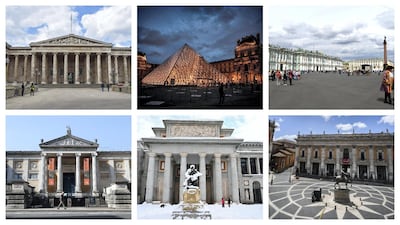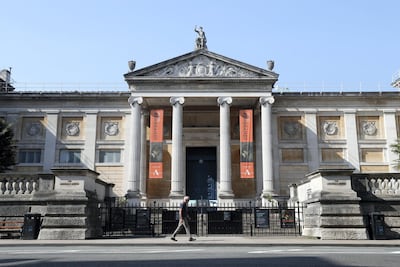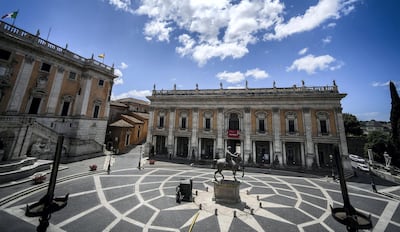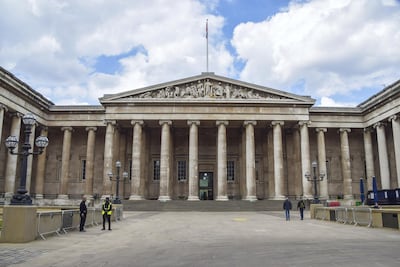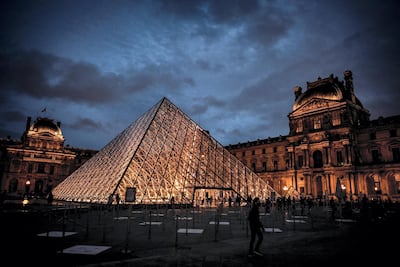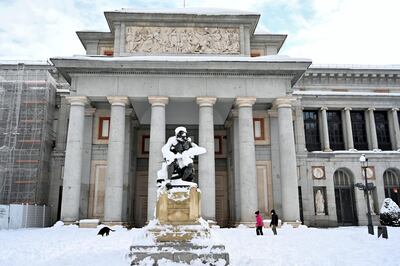Today marks International Museum Day, which was established by the International Council of Museums in 1977 as a way to engage its members – which now total 37,000 – in events and discussions around museology and the role of museums in the world.
It's hard to put an exact number on how many museums exist globally – organisations and researchers have proposed estimates of at least 55,000 in more than 200 countries.
Even in antiquity there is evidence of people collecting and preserving objects. But our modern definition of a museum has its roots in 17th to 18th-century Europe, where collections were placed on display in public squares and churches. This practice grew alongside expanding empires that extracted objects from their colonies, as well as the arrival of the Enlightenment.
Tracing the histories of six of the world's oldest museums reveals how these institutions and collections were built, and the ever-changing nature of these spaces today.
Ashmolean Museum
The foundations of this institution go back to Elias Ashmole, an English politician and lawyer who gave his collection of artefacts and other oddities to the University of Oxford, which constructed a building to house the objects. It opened to the public in 1683.
The museum is still open and running in Oxford, and its collection includes archaeological objects and fine art, such as Greek marbles, majolica pottery, antiquities from ancient Egypt, and artworks by Michelangelo, Raphael and Leonardo da Vinci.
Capitoline Museums
It has been referred to as the oldest museum in the world – the Musei Capitolini in Rome was created in 1471 when Pope Sixtus IV donated a collection of bronzes to the city.
The museum's collection soon grew to include Roman inscriptions, Medieval and Renaissance art, coins and jewels, and it eventually opened to the public in 1734.
Currently run by the municipality of Rome, the museum includes three main palazzos, as well as an open plaza. Among its most famous objects is the Capitoline Wolf, which tells the mythical story about the founding of Rome.
The British Museum
With its permanent collection of at least eight million works, The British Museum in London reflects the reach and power of the British Empire, but its history has also brought in controversy and debate about the restitution and repatriation of artefacts.
Established in 1753 by an Act of Parliament during the reign of King George II, it is considered the world's first public national museum and it began welcoming visitors in 1759.
Among the highlights of its collection are the Elgin or Parthenon Marbles from Greece that date back to about 447 to 4398 BC, as well as Egypt's Rosetta Stone. It possesses more than 100,000 Egyptian antiquities, and objects from the Classical world and the Middle East.
Louvre Museum
The most-visited museum in the world, the Louvre in Paris opened in 1793. Today, it contains more than 380,000 objects and 35,000 artworks, including Leonardo's Mona Lisa.
From about the 16th century, the building was used as a palace for the French monarchy before Louis XIV left it for the Palace of Versailles in 1682 with the royal collection kept inside.
Over the next century, art academies thrived in the Louvre until the National Assembly, born out of the French Revolution, ordered the building to be turned into a museum, housing objects from Napoleon’s reign and the royal collections.
Prado Museum
The Museo Nacional del Prado in Madrid contains objects from the Spanish Royal Collection and houses an impressive range of the country's art.
The building was designed in 1785 and was eventually assigned by a member of the Spanish monarchy as a venue to keep its collection of paintings and sculptures, but also to bolster the image of the Spanish Crown.
In 1819, the museum opened to the public for the first time and it currently has more than 7,000 paintings in its collection. Among its most notable works is Diego Velazquez's Las Meninas, which depicts Margaret Theresa of Spain as a child surrounded by her ladies-in-waiting. The painting is prized for its unique composition, with Velazquez playing with perspective and focal points, showing subjects who seemingly look out to the viewer.
The museum’s collection also includes masterpieces by Francisco Goya, Hieronymus Bosch and Titian.
Hermitage Museum
The State Hermitage Museum in Saint Petersburg, Russia, came to be through the efforts of Empress Catherine the Great. A strong supporter of the arts and education, she prompted the construction of the museum with the intent of housing and showcasing her collection of various items, which included paintings, books and sculpture.
The museum was founded in 1764 and it opened to the public in 1852, housing a large number of items – close to three million – from prehistoric art and antiquities to jewellery and European art, as well as a collection of Central Asian art.
_________________
Read more:
How Louvre Abu Dhabi is looking at the future
Bonhams sale of Madhloom and Makiya collections reunites two bastions of Iraqi art
_________________
CHATGPT%20ENTERPRISE%20FEATURES
%3Cp%3E%E2%80%A2%20Enterprise-grade%20security%20and%20privacy%3C%2Fp%3E%0A%3Cp%3E%E2%80%A2%20Unlimited%20higher-speed%20GPT-4%20access%20with%20no%20caps%3C%2Fp%3E%0A%3Cp%3E%E2%80%A2%20Longer%20context%20windows%20for%20processing%20longer%20inputs%3C%2Fp%3E%0A%3Cp%3E%E2%80%A2%20Advanced%20data%20analysis%20capabilities%3C%2Fp%3E%0A%3Cp%3E%E2%80%A2%20Customisation%20options%3C%2Fp%3E%0A%3Cp%3E%E2%80%A2%20Shareable%20chat%20templates%20that%20companies%20can%20use%20to%20collaborate%20and%20build%20common%20workflows%3C%2Fp%3E%0A%3Cp%3E%E2%80%A2%20Analytics%20dashboard%20for%20usage%20insights%3C%2Fp%3E%0A%3Cp%3E%E2%80%A2%20Free%20credits%20to%20use%20OpenAI%20APIs%20to%20extend%20OpenAI%20into%20a%20fully-custom%20solution%20for%20enterprises%3C%2Fp%3E%0A
Electric scooters: some rules to remember
- Riders must be 14-years-old or over
- Wear a protective helmet
- Park the electric scooter in designated parking lots (if any)
- Do not leave electric scooter in locations that obstruct traffic or pedestrians
- Solo riders only, no passengers allowed
- Do not drive outside designated lanes
The specs
Engine: 2.0-litre 4-cyl turbo
Power: 201hp at 5,200rpm
Torque: 320Nm at 1,750-4,000rpm
Transmission: 6-speed auto
Fuel consumption: 8.7L/100km
Price: Dh133,900
On sale: now
Groom and Two Brides
Director: Elie Semaan
Starring: Abdullah Boushehri, Laila Abdallah, Lulwa Almulla
Rating: 3/5
School counsellors on mental well-being
Schools counsellors in Abu Dhabi have put a number of provisions in place to help support pupils returning to the classroom next week.
Many children will resume in-person lessons for the first time in 10 months and parents previously raised concerns about the long-term effects of distance learning.
Schools leaders and counsellors said extra support will be offered to anyone that needs it. Additionally, heads of years will be on hand to offer advice or coping mechanisms to ease any concerns.
“Anxiety this time round has really spiralled, more so than from the first lockdown at the beginning of the pandemic,” said Priya Mitchell, counsellor at The British School Al Khubairat in Abu Dhabi.
“Some have got used to being at home don’t want to go back, while others are desperate to get back.
“We have seen an increase in depressive symptoms, especially with older pupils, and self-harm is starting younger.
“It is worrying and has taught us how important it is that we prioritise mental well-being.”
Ms Mitchell said she was liaising more with heads of year so they can support and offer advice to pupils if the demand is there.
The school will also carry out mental well-being checks so they can pick up on any behavioural patterns and put interventions in place to help pupils.
At Raha International School, the well-being team has provided parents with assessment surveys to see how they can support students at home to transition back to school.
“They have created a Well-being Resource Bank that parents have access to on information on various domains of mental health for students and families,” a team member said.
“Our pastoral team have been working with students to help ease the transition and reduce anxiety that [pupils] may experience after some have been nearly a year off campus.
"Special secondary tutorial classes have also focused on preparing students for their return; going over new guidelines, expectations and daily schedules.”
What can victims do?
Always use only regulated platforms
Stop all transactions and communication on suspicion
Save all evidence (screenshots, chat logs, transaction IDs)
Report to local authorities
Warn others to prevent further harm
Courtesy: Crystal Intelligence
Pharaoh's curse
British aristocrat Lord Carnarvon, who funded the expedition to find the Tutankhamun tomb, died in a Cairo hotel four months after the crypt was opened.
He had been in poor health for many years after a car crash, and a mosquito bite made worse by a shaving cut led to blood poisoning and pneumonia.
Reports at the time said Lord Carnarvon suffered from “pain as the inflammation affected the nasal passages and eyes”.
Decades later, scientists contended he had died of aspergillosis after inhaling spores of the fungus aspergillus in the tomb, which can lie dormant for months. The fact several others who entered were also found dead withiin a short time led to the myth of the curse.
Global state-owned investor ranking by size
|
1.
|
United States
|
|
2.
|
China
|
|
3.
|
UAE
|
|
4.
|
Japan
|
|
5
|
Norway
|
|
6.
|
Canada
|
|
7.
|
Singapore
|
|
8.
|
Australia
|
|
9.
|
Saudi Arabia
|
|
10.
|
South Korea
|
Points about the fast fashion industry Celine Hajjar wants everyone to know
- Fast fashion is responsible for up to 10 per cent of global carbon emissions
- Fast fashion is responsible for 24 per cent of the world's insecticides
- Synthetic fibres that make up the average garment can take hundreds of years to biodegrade
- Fast fashion labour workers make 80 per cent less than the required salary to live
- 27 million fast fashion workers worldwide suffer from work-related illnesses and diseases
- Hundreds of thousands of fast fashion labourers work without rights or protection and 80 per cent of them are women
UAE currency: the story behind the money in your pockets
Results
5.30pm: Maiden (TB) Dh82,500 (Dirt) 1,600m, Winner: Panadol, Mickael Barzalona (jockey), Salem bin Ghadayer (trainer)
6.05pm: Maiden (TB) Dh82,500 (Turf) 1,400m, Winner: Mayehaab, Adrie de Vries, Fawzi Nass
6.40pm: Handicap (TB) Dh85,000 (D) 1,600m, Winner: Monoski, Mickael Barzalona, Salem bin Ghadayer
7.15pm: Handicap (TB) Dh102,500 (T) 1,800m, Winner: Eastern World, Royston Ffrench, Charlie Appleby
7.50pm: Handicap (TB) Dh92,500 (D) 1,200m, Winner: Madkal, Adrie de Vries, Fawzi Nass
8.25pm: Handicap (TB) Dh92,500 (T) 1,200m, Winner: Taneen, Dane O’Neill, Musabah Al Muhairi
Water waste
In the UAE’s arid climate, small shrubs, bushes and flower beds usually require about six litres of water per square metre, daily. That increases to 12 litres per square metre a day for small trees, and 300 litres for palm trees.
Horticulturists suggest the best time for watering is before 8am or after 6pm, when water won't be dried up by the sun.
A global report published by the Water Resources Institute in August, ranked the UAE 10th out of 164 nations where water supplies are most stretched.
The Emirates is the world’s third largest per capita water consumer after the US and Canada.
The Breadwinner
Director: Nora Twomey
Starring: Saara Chaudry, Soma Chhaya, Laara Sadiq
Three stars
Brief scores:
Southampton 2
Armstrong 13', Soares 20'
Manchester United 2
Lukaku 33', Herrera 39'
Grand Slam Los Angeles results
Men:
56kg – Jorge Nakamura
62kg – Joao Gabriel de Sousa
69kg – Gianni Grippo
77kg – Caio Soares
85kg – Manuel Ribamar
94kg – Gustavo Batista
110kg – Erberth Santos
Women:
49kg – Mayssa Bastos
55kg – Nathalie Ribeiro
62kg – Gabrielle McComb
70kg – Thamara Silva
90kg – Gabrieli Pessanha
More from Neighbourhood Watch:
